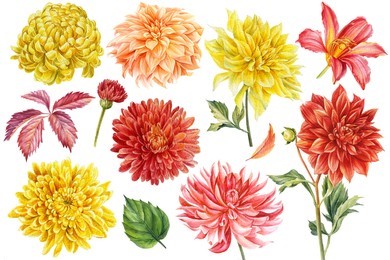Learn How to Draw a Chrysanthemum Bloom

Drawing of Ogiku, or Big Chrysanthemum
Draw a chrysanthemum flower is a general theme in the art of various cultures and is fun to draw. You will often find it used in Japanese art, Chinese scroll paintings, and Korean celadon vase. It also offers a variety of cultural and metaphorical meanings to feng shui, pagan laws, and traditional Chinese culture.
The Japanese word otaku means “large chrysanthemum.” For the drawing lesson, we will use a flower classified as an “irregular disease-free.” In the end, you will have a simple line drawing of a large flower moved to the corner of the paper. This is a simple project that anyone can do and great practice for beginners.
Supplies Required
This tutorial is an easy line drawing. So you can keep the paper and pen or pencil. You need to work with. It can be a drawing skill for your sketchbook in graphite or an excellent finished drawing in pen and ink. Whatever you want, the goal is to maintain it clean and simple.
Finding a Chrysanthemum to Draw
As always, it’s a good idea to find the right reference image to draw from it. Drawing while looking at a natural flower is better, but you can do it with a photograph.
To share your work without copyright restrictions, you should try to take your photos. This is a great reason to snap photos when you see a great flower because you never know when to use it for reference.
If you don’t have your photo, another option is to find a creative commons license. There are some great websites available for this, and one of the best is Flickr. You can filter search results to include only those licensed “Creative Commons” and narrow it down beyond those you can commercially use.
By doing this and reading any specific conditions for a particular photo, you can feel good if you decide to sell the artwork you created from the picture. For example, the image used in this tutorial was made available under Creative Commons (CC BY 2.0) Keith’ Pheanix’.
Start your Drawing
Draw a chrysanthemum is a large and complex flowering, and it can be not very clear to know where to start. It helps if you start with a light sketch of the overall shape of the flower.
Make a Rough Outline
Looking at your subject, notice how tightly closed petals form a ball shape, with a circle towards the center where the petals are glistening inside. Then, test and measure how comprehensive the expanded flower parts are and sketch curves to indicate those. This will help you keep your flowers in reasonable proportions.
Remember that these are guides only. Keep your lines very light and feel as if you have to stick to them while you draw. Most flowers have many natural variations. Unless you are making an accurate botanical description, you can exercise some artistic license.
Start With The Main Petals
Everyone approaches their drawing ideas in different ways. When it is a line drawing like this, you may find it best to start with the petals that form the complete shape and are closest to the viewer. The other petals seem to sit behind them.
Draw petals that form continuous closed shapes first. Add those that join against or behind the next. Keep your lines relaxed and flowing.
Drawing a Chrysanthemum
When you have several petals in place, keep adding to it one petal at a time. Notice how some come and join under the ones you’ve already drawn. Others are releasing behind adjacent petals.
Try not to worry about mistakes. You want to keep a line drawing clean and straightforward. If you decide to redo a line, it just draws awareness to the error. The flowers always have weird curls or uneven pieces, so no one will notice the difference as long as your lines are smooth.
Keep adding one pedal at a time. Proceed to look at the picture and the petals. You have drawn as a source to position everyone correctly.
You can see in your photo if your drawing is longer than the page or shorter than the one next to it. Also, compare the width of the petals. Pay attention only to the most robust line to copy.
The Finished Chrysanthemum Design
With a bit of patience, it doesn’t take too long to finish flowering. The drawing example is close to the photograph to make it easier to see how the two relate. However, you can be more creative with your drawing.
The chrysanthemum lends itself to exciting lines. Try increasing longer petals with exciting curves or planning a more minimal, simplistic interpretation.
With a bit of thought and the tips, you chose up in this lesson. You have an excellent start for your next chrysanthemum drawing.
Source: Econarticle






